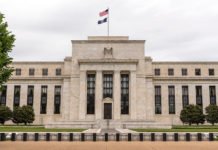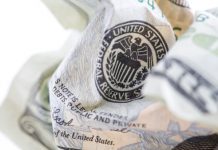EUR/USD is almost unchanged on Wednesday, following gains in the Tuesday session. Currently, the pair is trading just above the 1.07 level. On the release front, Eurozone Final CPI came in at 1.5%, matching the forecast. The Eurozone trade surplus jumped to EUR 19.2 billion, above the estimate of EUR 18.6 billion. There are no major US releases on the schedule. On Thursday, the US releases the Philly Fed Manufacturing Index and unemployment claims. As well, US Treasury Secretary Steven Mnuchin will speak at event in Washington.
Eurozone consumer inflation indicators dropped in March, but matched the forecasts. Eurozone Final CPI slipped to 1.5%, compared to 2.0% a month earlier. The indicator had been steadily rising, and climbed to 2.0% in February, which is the ECB’s inflation target. This had led to speculation that the ECB might have to consider tightening its monetary policy, either by lowering interest rates or tapering its asset-purchase program (QE). The ECB’s asset-purchase program is scheduled to remain in place until December, although the central bank could opt to bring up that date or taper the program if growth and inflation numbers in the Eurozone are unexpectedly strong. There are also political considerations at play, as the ECB is reluctant to make any significant monetary moves with upcoming elections in France and Germany.
Investors are closely following the French presidential election, with the first round of voting on April 23. The race remains extremely tight, with centrist Emmanuel Macron and far-right candidate Marine Le Pen tied at 22 percent. They are followed by center-right Francois Fillon at 21% and far-left Jean-Luc Melenchon at 18 percent. If Macron and Le Pen reach the second round, Macron is expected to win decisively by a margin of 64-36. With only a few days to go before the vote, polling numbers will be closely watched, and any significant changes in the polls could impact on the euro.
The Federal Reserve has broadly hinted that it plans two more rate hikes in 2017. There have been calls from some Fed policymakers to raise rates three more times, but this seems unlikely, given disappointing retail sales and CPI numbers in March. These weak numbers are likely to make the Fed more dovish, and prompted the Atlanta and New York Federal Reserve banks to lower their outlook for US economic growth for the first quarter of 2017. The Fed can point to a labor market that is close to capacity as well as strong consumer confidence, but this has not translated into stronger consumer spending, a key driver of economic growth. What can we expect next from the Fed? The odds of a rate hike in June are currently priced at 55%, according to the CME Group, down from 65% earlier in April.












